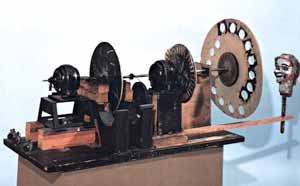Mechanical Television
Mechanical Television
The Russian Constantin Perskyi invented the word Television in 1900 at a meeting in Paris to describe devices that make pictures using electricity. At the time, many inventors were creating pieces of what we would now recognize as TV. But back then, television (TV) had many names.
Paul Nipkow (Germany) received the first patent for a TV-like machine in 1884. His mechanical system used a scanning disk that broke a picture into pieces and then reassembled it on a picture receiver. By 1930 British hobbyists were buying mechanical TV systems. Scotsman John Logie Baird improved Nipkow’s system. He sent out TV pictures on the British Broadcasting Corporation’s (BBC) radio equipment.
Mechanical TV had a big problem—it needed a lot of light. The poor actors broiled under the bright lights, but most of the light was wasted anyway. Because the pictures were so dim, you needed to watch TV in the dark, like in a movie theatre. It was not very practical for your living room.
Meanwhile, other companies, such as Britain’s Electric and Musical Industries (EMI) started promoting their own electronic TV systems. In 1936 EMI’s electronic TV system won a competition against Baird's mechanical TV system. The industry agreed that electronic systems were better. Mechanical TV systems soon disappeared.
